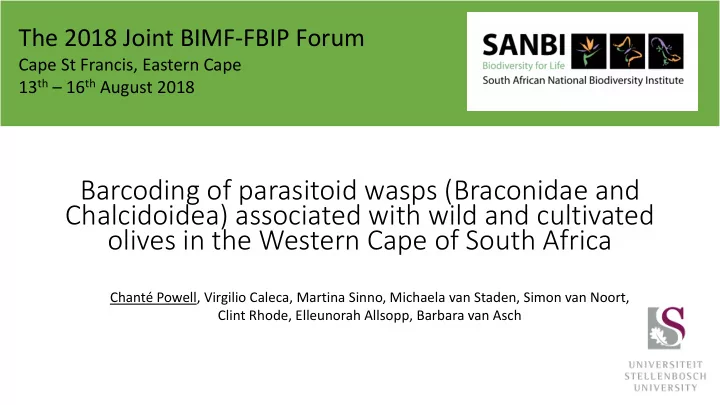

The 2018 Joint BIMF-FBIP Forum Cape St Francis, Eastern Cape 13 th – 16 th August 2018 Barcoding of parasitoid wasps (Braconidae and Chalcidoidea) associated with wild and cultivated olives in the Western Cape of South Africa Chanté Powell, Virgilio Caleca, Martina Sinno, Michaela van Staden, Simon van Noort, Clint Rhode, Elleunorah Allsopp, Barbara van Asch
Introduction Wild and cultivated olives host a variety of insects Rich assemblage of native wasps www.tokopedia.com • Natural enemies of olive fruit flies • Pests • Status unknown Bactrocera oleae Bactrocera biguttala 1
Research aim To associate DNA barcoding sequences with morphologically identified braconid and chalcid wasps reared from wild and cultivated olives 2
Workflow DNA extraction, Morphological ID Phylogenetics & PCR Sample collection & photographic sequence amplification & imaging divergence sequencing www.winelandsweb.co.za innoliva.com www.sciencedirect.com 3
Braconidae – Four species Novel reference sequences for Psyttalia lounsburyi Psyttalia humilis two species Utetes africanus Bracon celer 4
Braconidae – Successful example Neighbour- joining tree Pysttalia intraspecific genetic distances (%) n Min Max Mean P. carinata 6 0.20 1.70 0.80 ± 0.002 P. concolor 6 0.00 0.70 0.30 ± 0.001 P. fletcheri 6 0.00 0.30 0.10 ± 0.001 P. humilis 9 0.00 1.30 0.80 ± 0.003 P. lounsburyi 31 0.00 1.30 0.50 ± 0.002 P. ponerophaga 5 0.30 0.80 0.50 ± 0.002 5
Braconidae – Unsuccessful example Neighbour-joining tree 6
Chalcidoidae – Five species Novel reference Eurytoma oleae Eurytoma varicolor Sycophila aethiopica sequences for four species Eupelmus spermophilus Ormyrus sp. Neochrysocharis 7 formosus
Chalcidoidae – Successful example Neighbour-joining tree Eupelmus intraspecific genetic distances (%) n Min Max Mean E. annulatus 9 0.00 8.70 4.50 ± 0.007 E. azureus 10 0.20 5.60 2.59 ± 0.004 E. confusus 38 0.00 6.90 1.91 ± 0.003 E. gemellus 21 0.00 2.70 1.32 ± 0.003 E. kiefferi 25 0.00 5.50 1.62 ± 0.003 E. longicalvus 7 0.60 4.80 2.41 ± 0.004 E. minozonus 5 0.20 2.70 1.57 ± 0.004 E. spermophilus 10 0.40 2.30 1.12 ± 0.003 E. urozonus 25 0.20 4.00 1.61 ± 0.003 8
Chalcidoidae – Unsuccessful example Neighbour-joining tree 9
Conclusions & Future developments Morphological ID congruent with DNA data (six species) • Difficulties highlight importance of good taxonomic coverage No clear evidence for cryptic diversity Early detection of invasions, dissemination and infestation outbreaks Egg Larva Pupa 10 www.researchgate.net
Acknowledgements Olive growers and landowners FBIP – Small Grants and Biodiversity Surveys 11
Thank you for listening!
Braconidae – Successful example P. humilis intraspecific genetic distances (%) n Min Max Mean P. humilis (this study) 3 0.00 0.30 0.00 ± 0.001 Pysttalia interspecific mean genetic distances (%) P. humilis (Genbank) 6 0.00 1.30 0.70 ± 0.002 1 2 3 4 5 6 P. carinata − 0.014 0.017 0.015 0.014 0.012 P. lounsburyi intraspecific genetic distances (%) P. concolor 12.50 − 0.014 0.008 0.012 0.013 P. fletcheri 16.30 12.40 − 0.015 0.014 0.017 n Min Max Mean P. humilis 13.20 13.20 13.00 − 0.012 0.014 P. lounsburyi (this study) 4 0.20 0.30 0.20 ± 0.001 P. lounsburyi 13.20 9.20 11.70 8.80 − 0.015 P. lounsburyi (Genbank) 27 0.00 1.30 0.40 ± 0.001 P. ponerophaga 8.30 11.50 16.00 12.20 13.40 −
Chalcidoidae – Successful example Eupelmus intraspecific genetic distances (%) n Min Max Mean E. annulatus 9 0.00 8.70 4.50 ± 0.007 E. azureus 10 0.20 5.60 2.59 ± 0.004 E. confusus 38 0.00 6.90 1.91 ± 0.003 Eupelmus interspecific mean genetic distances (%) E. gemellus 21 0.00 2.70 1.32 ± 0.003 E. kiefferi 25 0.00 5.50 1.62 ± 0.003 E. longicalvus 7 0.60 4.80 2.41 ± 0.004 1 2 3 4 5 6 7 8 9 E. minozonus 5 0.20 2.70 1.57 ± 0.004 E. annulatus − 0.016 0.016 0.013 0.016 0.015 0.017 0.018 0.016 E. azureus 13.40 − 0.015 0.015 0.016 0.015 0.016 0.018 0.016 E. spermophilus 10 0.40 2.30 1.12 ± 0.003 E. confusus 13.80 13.80 − 0.014 0.016 0.012 0.014 0.017 0.014 E. urozonus 25 0.20 4.00 1.61 ± 0.003 E. gemellus 10.90 13.10 11.00 − 0.014 0.013 0.014 0.017 0.015 E. kiefferi 14.30 13.80 13.70 11.70 − 0.016 0.014 0.017 0.013 E. longicalvus 12.70 13.70 10.30 10.20 13.60 − 0.015 0.017 0.015 E. minozonus 15.80 15.40 12.10 11.90 12.20 12.30 − 0.017 0.011 E. spermophilus 17.00 16.90 15.90 15.90 16.10 15.50 15.10 − 0.017 E. urozonus 13.80 14.80 12.10 12.10 10.90 12.50 7.80 16.1 −
Recommend
More recommend